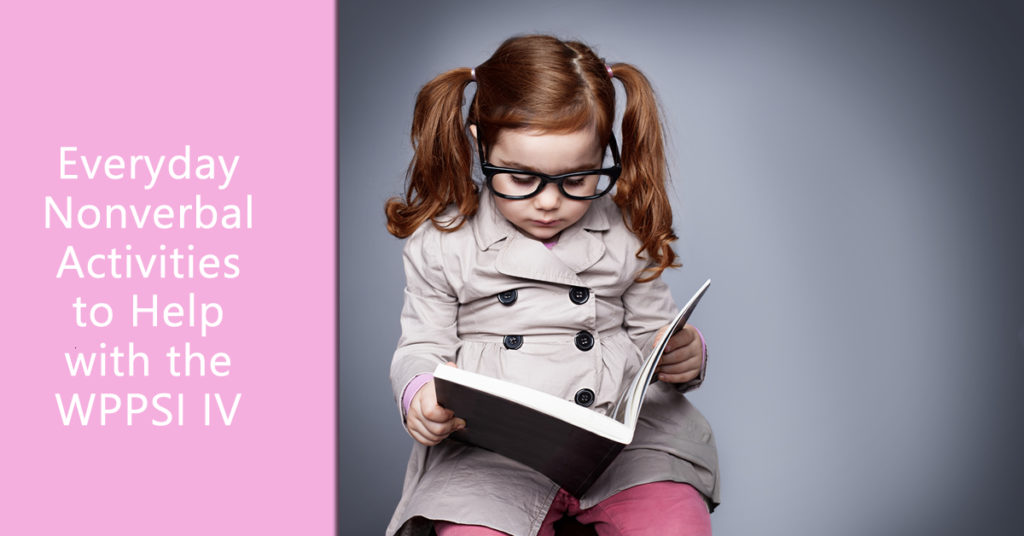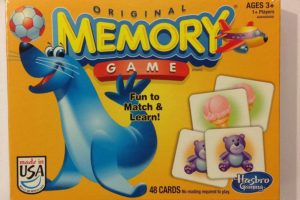› Everyday Activities that Help with the WPPSI™ IV Subtests: Nonverbal
Everyday Activities that Help with the WPPSI™ IV Subtests: Nonverbal
posted by Karen Quinn, The Testing Mom - August 30th, 2017
This post is a continuation of our series on every day activities for WPPSI IV Subtests. Last week, we discussed practicing for the WPPSI IV Verbal Subtests
Today I want to focus on everyday activities that can help your child with the WPPSI IV Nonverbal subtests. These questions do not require verbal responses, and are often used at when determining if a child is gifted or not. Additionally, these subtests may be useful to evaluate children who are deaf or hard of hearing, or suspected of having language or autistic spectrum disorders.

What’s on the WPPSI IV Nonverbal Index Subtests Anyway?
Your child will take either 3 or 6 subtests when taking the WPPSI-IV, depending on how old he is. These are outlined below. (The ages are years, then months, so 2:6 means 2 and a half years old.)
Ages 2:6 – 3:11 Nonverbal Index
Block Design has your child recreate block patterns using red and white 3-D blocks with solid or diagonal designs. Patterns are recreated after looking at actual models and at printed images.
Object Assembly measures the time it takes your child to arrange various pieces together to form a meaningful whole image.
Picture Memory tests your child’s ability to select a picture from a few options, after the child has been shown a stimulus page.
Zoo Location has your child view one or more animal cards placed on a zoo layout for a specified time and then places each card in the previously viewed locations.
Ages 4:0 – 7:7 Nonverbal Index
Block Design has your child recreate block patterns using red and white 3-D blocks with solid or diagonal designs. Patterns are recreated after looking at actual models and at printed images.
Object Assembly measures the time it takes your child to arrange various pieces together to form a meaningful whole image.
Matrix Reasoning is where your child figures out what is missing in a 4-box matrix based on the relationship between the pictures in the top two boxes.
Picture Concepts is where your child chooses 2 to 3 pictures that belong together after looking at 2 to 3 rows of various pictures.
Picture Memory tests your child’s ability to select a picture from a few options, after the child has been shown a stimulus page.
Zoo Location has your child view one or more animal cards placed on a zoo layout for a specified time and then places each card in the previously viewed locations.
Bug Search is a child-friendly adaptation of Symbol Search, this subtest features engaging, colorful stimuli of familiar bugs rather than abstract images. Your child is shown a bug and must recognize if there is a matching bug among the answer choices.
Cancellation features clothing targets and other objects that are very familiar to young children. Two items include one with a random arrangement of objects and one with a structured arrangement. Comparison of item performance can provide useful information about how the child’s ability varies with the mode of presentation.
Animal Coding is an adaptation of Coding. This subtest pairs familiar and appealing animals with basic shapes rather than pairing abstract symbols with basic shapes. The number of paired associates is reduced from five to three, based on the more limited memory capacity of young children.
Everyday Activities that Help Your Child with the WPPSI IV
 Play memory games with your child. These are made now with almost any “favorite” character or subject that interests your child. The idea is to build your child’s concentration and memory skills by turning all the cards over and then having them flip over cards two at a time and find the matches. Or you could even make your own cards, print the pictures and glue them to square cut stock paper.
Play memory games with your child. These are made now with almost any “favorite” character or subject that interests your child. The idea is to build your child’s concentration and memory skills by turning all the cards over and then having them flip over cards two at a time and find the matches. Or you could even make your own cards, print the pictures and glue them to square cut stock paper.- Logic problems are both fun and work that connecting part in your child’s brain to associate cause and effect and to learn how to eliminate impossible answers. You can find tons on Pinterest to print and practice. Here is one you can print and try now.
- Read books aloud to solidify knowledge and comprehension. Knowledge and comprehension are your child’s understanding of information, social standards of behavior, and common sense that children his age usually understand.
- Find coded coloring pages, where your child colors a certain “code” a specific color, like this one (again, I found it on Pinterest, but you can search coded coloring pages for kids, as well). This is especially fun, when the picture is hidden until the code reveals a fun character or animal!
- Have your kids play games with design blocks like the ones found here. These blocks are similar to the pattern questions that are asked on the test and can help build the necessary skills needed to excel on these types of questions.
- One of the best ways to prepare for the WPPSI is with the game IQ Fun Pack. IQ Fun Pack utilizes questions from some of the most popular tests (including the WPPSI) to help prepare your kids for the test in a way that’s challenging and so much fun that they will love test prep. Click here to see the perspective of parent who has had success with IQ Fun Pack.
The key is to be engaged with your child. Talk about everything! Ask questions to gauge your child’s understanding. You can enjoy offline activities and turn them into learning opportunities!
Finally check out our other resources on our WPPSI™ IV Test pages:



Tell us about your experiences